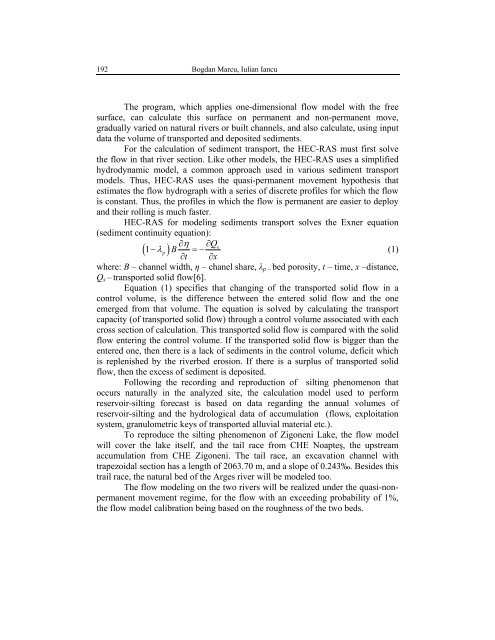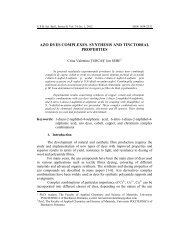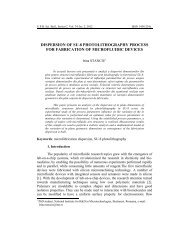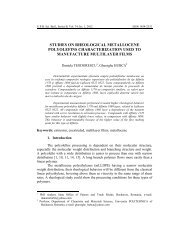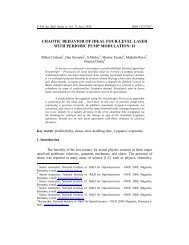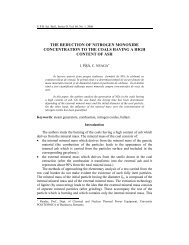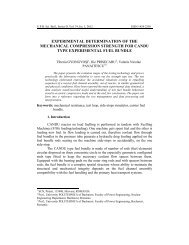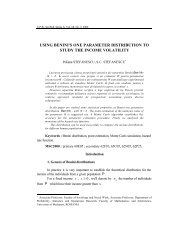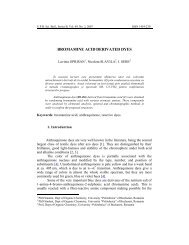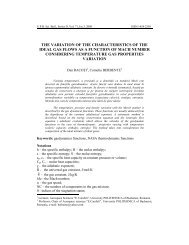research on silting and desilting of reservoirs - Scientific Bulletin
research on silting and desilting of reservoirs - Scientific Bulletin
research on silting and desilting of reservoirs - Scientific Bulletin
You also want an ePaper? Increase the reach of your titles
YUMPU automatically turns print PDFs into web optimized ePapers that Google loves.
192 Bogdan Marcu, Iulian Iancu<br />
The program, which applies <strong>on</strong>e-dimensi<strong>on</strong>al flow model with the free<br />
surface, can calculate this surface <strong>on</strong> permanent <strong>and</strong> n<strong>on</strong>-permanent move,<br />
gradually varied <strong>on</strong> natural rivers or built channels, <strong>and</strong> also calculate, using input<br />
data the volume <strong>of</strong> transported <strong>and</strong> deposited sediments.<br />
For the calculati<strong>on</strong> <strong>of</strong> sediment transport, the HEC-RAS must first solve<br />
the flow in that river secti<strong>on</strong>. Like other models, the HEC-RAS uses a simplified<br />
hydrodynamic model, a comm<strong>on</strong> approach used in various sediment transport<br />
models. Thus, HEC-RAS uses the quasi-permanent movement hypothesis that<br />
estimates the flow hydrograph with a series <strong>of</strong> discrete pr<strong>of</strong>iles for which the flow<br />
is c<strong>on</strong>stant. Thus, the pr<strong>of</strong>iles in which the flow is permanent are easier to deploy<br />
<strong>and</strong> their rolling is much faster.<br />
HEC-RAS for modeling sediments transport solves the Exner equati<strong>on</strong><br />
(sediment c<strong>on</strong>tinuity equati<strong>on</strong>):<br />
∂η<br />
∂Qs<br />
( 1− λp<br />
) B =−<br />
(1)<br />
∂ t ∂ x<br />
where: B – channel width, η – chanel share, λ p – bed porosity, t – time, x –distance,<br />
Q s – transported solid flow[6].<br />
Equati<strong>on</strong> (1) specifies that changing <strong>of</strong> the transported solid flow in a<br />
c<strong>on</strong>trol volume, is the difference between the entered solid flow <strong>and</strong> the <strong>on</strong>e<br />
emerged from that volume. The equati<strong>on</strong> is solved by calculating the transport<br />
capacity (<strong>of</strong> transported solid flow) through a c<strong>on</strong>trol volume associated with each<br />
cross secti<strong>on</strong> <strong>of</strong> calculati<strong>on</strong>. This transported solid flow is compared with the solid<br />
flow entering the c<strong>on</strong>trol volume. If the transported solid flow is bigger than the<br />
entered <strong>on</strong>e, then there is a lack <strong>of</strong> sediments in the c<strong>on</strong>trol volume, deficit which<br />
is replenished by the riverbed erosi<strong>on</strong>. If there is a surplus <strong>of</strong> transported solid<br />
flow, then the excess <strong>of</strong> sediment is deposited.<br />
Following the recording <strong>and</strong> reproducti<strong>on</strong> <strong>of</strong> <strong>silting</strong> phenomen<strong>on</strong> that<br />
occurs naturally in the analyzed site, the calculati<strong>on</strong> model used to perform<br />
reservoir-<strong>silting</strong> forecast is based <strong>on</strong> data regarding the annual volumes <strong>of</strong><br />
reservoir-<strong>silting</strong> <strong>and</strong> the hydrological data <strong>of</strong> accumulati<strong>on</strong> (flows, exploitati<strong>on</strong><br />
system, granulometric keys <strong>of</strong> transported alluvial material etc.).<br />
To reproduce the <strong>silting</strong> phenomen<strong>on</strong> <strong>of</strong> Zig<strong>on</strong>eni Lake, the flow model<br />
will cover the lake itself, <strong>and</strong> the tail race from CHE Noapteş, the upstream<br />
accumulati<strong>on</strong> from CHE Zig<strong>on</strong>eni. The tail race, an excavati<strong>on</strong> channel with<br />
trapezoidal secti<strong>on</strong> has a length <strong>of</strong> 2063.70 m, <strong>and</strong> a slope <strong>of</strong> 0.243‰. Besides this<br />
trail race, the natural bed <strong>of</strong> the Arges river will be modeled too.<br />
The flow modeling <strong>on</strong> the two rivers will be realized under the quasi-n<strong>on</strong>permanent<br />
movement regime, for the flow with an exceeding probability <strong>of</strong> 1%,<br />
the flow model calibrati<strong>on</strong> being based <strong>on</strong> the roughness <strong>of</strong> the two beds.


